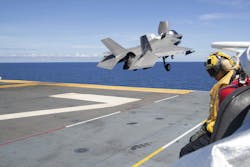Lockheed Martin prepares to build batch of F-35 combat jets, avionics, and sensors in $869.9 million deal
PATUXENT RIVER NAS, Md. – Combat aircraft designers at Lockheed Martin Corp. to build lot 20 of the F-35 combat jets for U.S. military services and allies under terms of a $869.9 million contract announced on Friday.
Officials of the U.S. Naval Air Systems Command at Patuxent River Naval Air Station, Md. -- the organization handling F-35 aviation technology procurement for all military forces -- are asking the Lockheed Martin Aeronautics segment in Fort Worth, Texas, for long lead items for F-35 lot 20 aircraft for the Air Force, Navy, Marine Corps, and foreign military sales (FMS).
One lot of F-35 combat jets typically consists of between 12 and 24 aircraft. Long-lead items either are difficult and time-consuming to obtain, and are funded early in the aircraft design process to keep overall production on schedule. Contracts to build lot 20 aircraft will come later.
5th-generation fighter
The F-35 with its advanced avionics is a fifth-generation single-seat, single-engine, all-weather stealth multirole jet fighter-bomber designed to perform ground attack, aerial reconnaissance, and air defense missions. It is one of the most advanced combat jets in the world.
Other than the U.S. military, F-35 operators include Australia; United Kingdom; Belgium; Denmark; Finland; Italy; Japan; The Netherlands; Norway; Poland; South Korea; Thailand; United Arab Emirates; Israel; and Singapore.
The F-35 is replacing U.S. F-16, A-10, F/A-18, and AV-8B tactical fighter and attack aircraft. Lockheed Martin has been developing the F-35 since 2001.
Mach 1.6
The single-seat F-35 military jet is 50.5 feet long, has 35-foot wingspan, and is 14 feet tall. It has one Pratt & Whitney F135 afterburning turbofan engine that can produce as much as 43,100 pounds of thrust.
The aircraft can fly as fast as Mach 1.6, as high as 50,000 feet, and has a range of 1,200 miles. It has one 25-millimeter Gatling gun and can carry advanced air-to-air missiles, air-to-ground missiles, smart bombs, and conventional bombs.
The F-35's avionics and sensors include the Northrop Grumman AN/APG-81 AESA radar; Lockheed Martin AAQ-40 electro-optical targeting system (EOTS); Northrop Grumman AN/AAQ-37 distributed aperture system (DAS) missile warning system; BAE Systems AN/ASQ-239 electronic warfare (EW) suite; and Northrop Grumman AN/ASQ-242 communications and navigation system.
The plane's navigation and communications include the Harris Corp. Multifunction Advanced Data Link (MADL); Link 16 data link; single-channel ground and airborne radio system (SINCGARS); IFF interrogator and transponder; HAVE QUICK radio; AM, VHF, UHF AM, and UHF FM radio systems; GUARD survival radio; radar altimeter; tactical air navigation (TACAN); instrument landing system for conventional runways and aircraft carriers; the Joint Precision Approach and Landing System (JPALS); and the TADIL-J tactical digital information link with Joint-Variable-Message-Format (JVMF) communications.
helmet-mounted displays
F-35 pilots wear a helmet-mounted display that enables them simply to look at a target to shoot weapons, rather than pointing the entire aircraft at the target. The orientation of the pilot's head provides missile seeker heads with targeting information.
The combat aircraft -- one of the most expensive military weapon systems in history -- is designed to perform ground attack, aerial reconnaissance, and air-to-air missions. U.S. military leaders say they plan to buy 2,457 aircraft.
The F-35 variants are intended to provide the bulk of the manned tactical air power of the U.S. Air Force, Navy, and Marine Corps. Deliveries of the F-35 for the U.S. military are scheduled to be completed in 2037.
Lockheed Martin and its partners will do the work on this contract in Fort Worth, Texas; El Segundo and San Diego, Calif.; Warton, England; Orlando, Fla.; Nashua, N.H.; Cameri, Italy; Baltimore; and other locations, and should be finished by May 2031.
For more information contact Lockheed Martin online at www.f35.com/f35/index.html, or Naval Air Systems Command at www.navair.navy.mil.
About the Author
John Keller
Editor-in-Chief
John Keller is the Editor-in-Chief, Military & Aerospace Electronics Magazine--provides extensive coverage and analysis of enabling electronics and optoelectronic technologies in military, space and commercial aviation applications. John has been a member of the Military & Aerospace Electronics staff since 1989 and chief editor since 1995.
